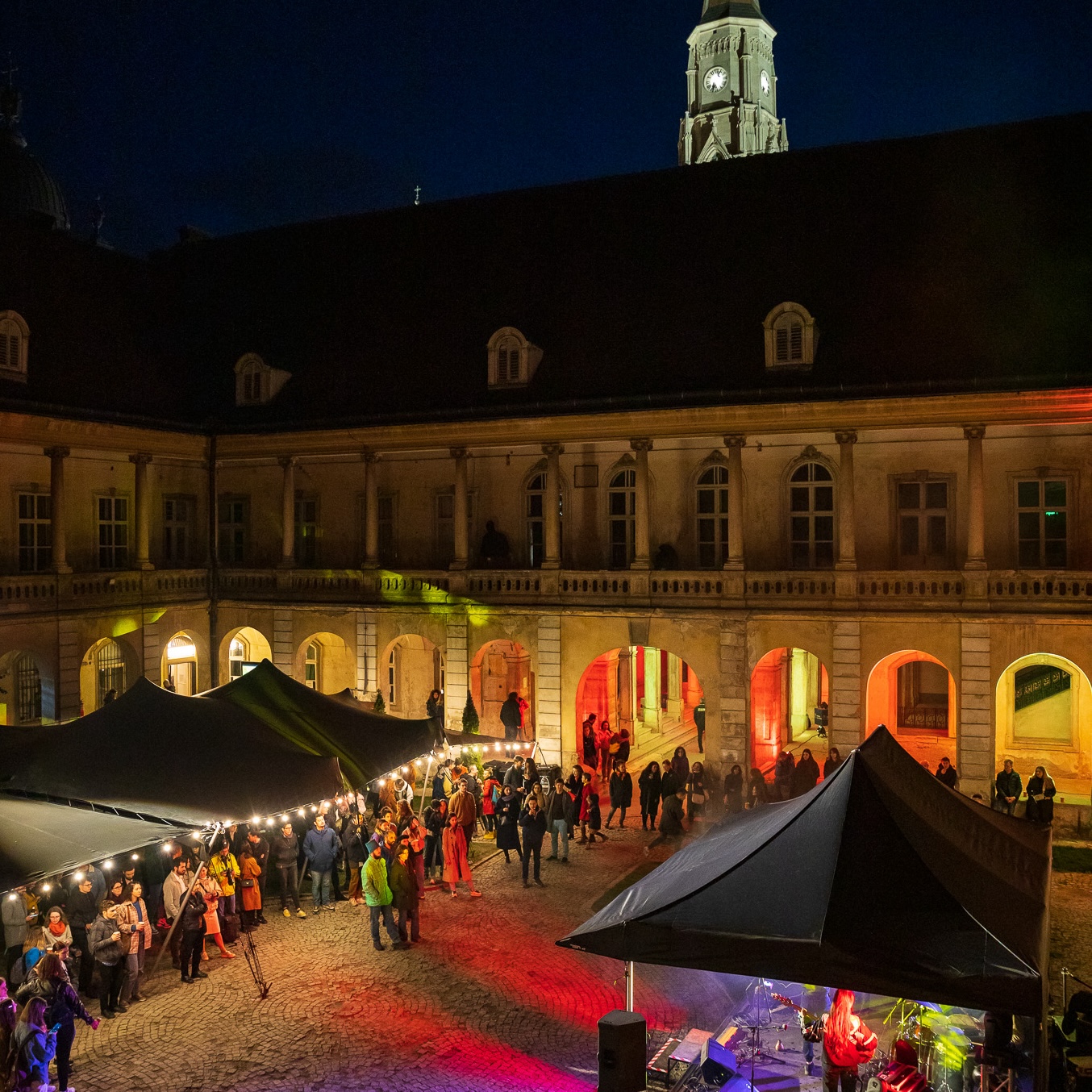VINYL COVERS – STYLES OF JAZZ
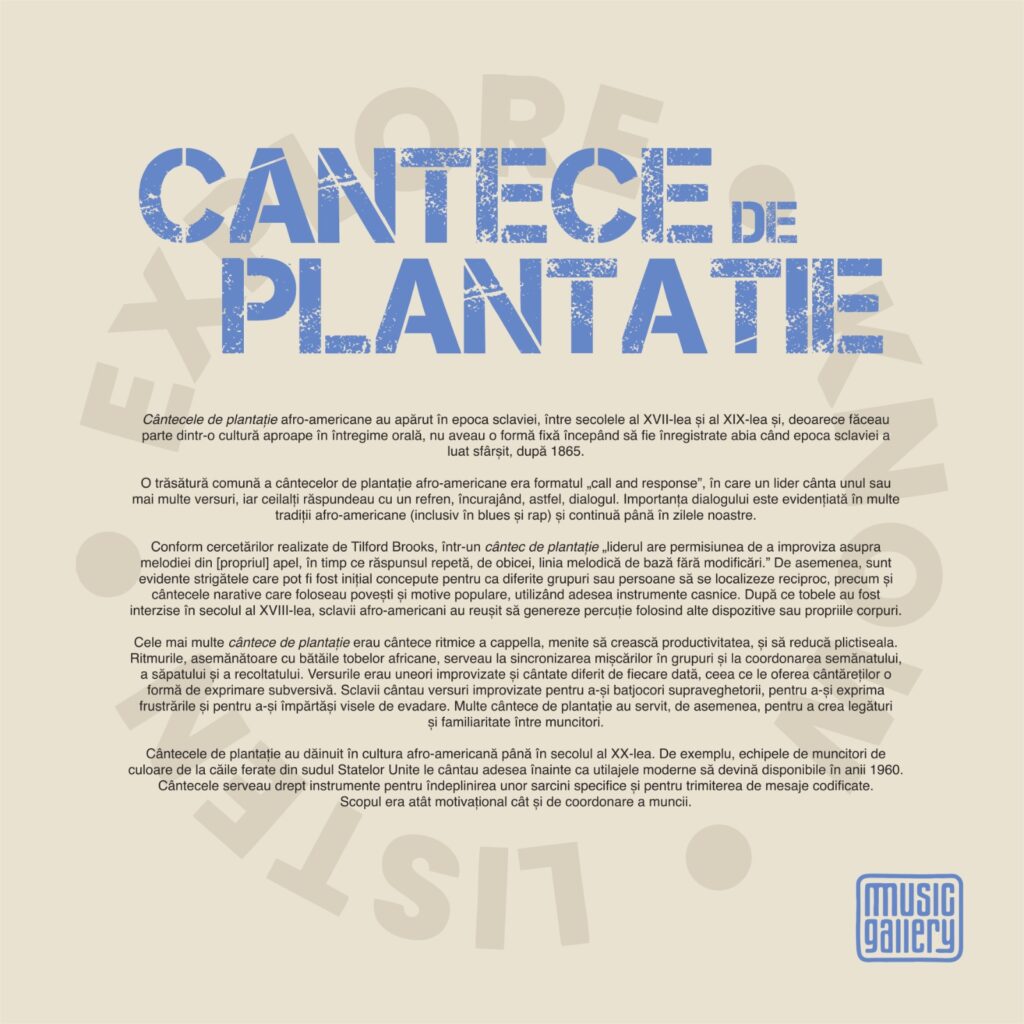
PLANTATION SONGS
African American plantation songs emerged during the era of slavery, between the 17th and 19th centuries. Since they were part of an almost entirely oral culture, they did not have a fixed form and were only recorded after the end of slavery in 1865.
A common feature of African American plantation songs was the “call and response” format, where a leader would sing one or more verses and the others would respond with a chorus, thus encouraging dialogue. The importance of dialogue is highlighted in many African American traditions (including blues and rap) and continues to this day.
According to research by Tilford Brooks, in a plantation song “the leader has permission to improvise on the melody of [their own] call, while the response usually repeats the basic melodic line without modification.” Also evident are the shouts that may have originally been intended for different groups or individuals to locate each other, as well as narrative songs that used popular stories and motifs, often using household instruments. After drums were banned in the 18th century, African American slaves managed to generate percussion using other devices or their own bodies.
Most plantation songs were rhythmic a cappella songs designed to increase productivity and reduce boredom. The rhythms, similar to African drum beats, served to synchronize movements in groups and coordinate planting, hoeing, and harvesting. The lyrics were sometimes improvised and sung differently each time, giving the singers a form of subversive expression. Slaves sang improvised verses to mock their overseers, express their frustrations, and share their dreams of escape. Many plantation songs also served to create connections and familiarity among workers.
Plantation songs persisted in African American culture until the 20th century. For example, black railroad worker teams in the southern United States often sang them before modern equipment became available in the 1960s. The songs served as tools for specific tasks and for sending coded messages. The goal was both motivational and coordination of work.

NEGRO SPIRITUALS
The Afro-American rhythms (negro spirituals), precursors to jazz, have their origins in the brutal institution of slavery, incorporating Christian and African cultural influences. The songs expressed the desire for a better life, identified with the children of Israel, exposed the deception and hypocrisy of slave masters, emphasized the need to draw closer to God, acknowledged the existence of Satan, and highlighted the hope of slaves for freedom and a better future. Love, grace, mercy, judgment, death, and eternal life were among the themes addressed in these songs.
The musical format originated in the informal gatherings of African slaves in “prayer houses” and open-air meetings in the 18th century. Participants would sing, dance, and sometimes enter into ecstatic trance states. This spiritual music also derived from the shouts during ring dances, songs, and hand clapping that were common among the early plantation slaves.
By the mid-1700s, free Afro-Americans began to form separate religious groups from white congregations, organized by educated Methodists, Baptists, or members of the Protestant sect Society of Friends (Quakers), particularly in the North. In some cases, these efforts culminated in the development of entirely independent Afro-American churches.
In 1870, the creation of the Jubilee Singers – a choir of former slaves from Fisk University in Nashville, Tennessee – sparked international interest in this musical form. The group’s touring program in the United States and Europe included concerts of Afro-American spirituals that were well-received by audiences. While some Afro-Americans at the time associated the spiritual tradition with slavery and were not enthusiastic about its continuation, the performances of the Fisk singers convinced many that it should be continued.
Key elements of negro spirituals include “call and response,” which has carried over into later musical genres such as blues, jazz, and gospel. In some respects, the spirituals were a form of resistance. Slaves did not want to conform to European customs and wanted to preserve African identity elements in their music. The social implications of Afro-American spirituals were tied to the abolition of slavery in 1865, the rebirth of African Americans, and the name of Martin Luther King Jr. In fact, Afro-American spirituals continue to serve their spiritual purpose. In the words of writer Pamela Crosby, “Afro-American spirituals still heal.”

BLUES
The influence of African music on blues is undeniable. The poetic structure and narrative lyrics carry on the oral tradition of West African cultures. Many African cultures produced music and sang using instruments similar to those found in America. Instruments such as the balafon (xylophone), the lute, drums, and aerophones made the assimilation of this new music faster. Some Africans managed to bring musical instruments with them or build new ones in their adopted country, such as the “banja” or “banshaw,” now known as the banjo. The oldest music similar to blues was a “functional expression, rendered in a call-and-response style, without accompaniment or harmony, and without being constrained by the formality of a particular musical structure.” This pre-blues music was adapted from the cries of plantation slaves and expanded into “simple, emotionally charged solo songs.”
Some historians date the blues genre as having its origins between 1870 and 1890, a period that coincides with the emancipation of slaves and the transition from slavery to land division and westward migration. Blues grew in the Mississippi Delta, just upstream from New Orleans, the birthplace of jazz. Blues and jazz have always influenced each other and continue to interact in countless ways today. Once Delta blues made its way up the Mississippi to urban areas, the music evolved into other regional blues styles and various jazz-blues hybrids. About a decade later, blues gave birth to rhythm and blues (R&B) and rock and roll.
Black women played an essential role in the popularity of blues. Gertrude “Ma” Rainey is credited with being the first to perform blues on stage as popular entertainment in her show around 1902, and Bessie Smith was the most popular blues singer of the 1920s and 1930s. Other great blues singers included Ethel Waters, Alberta Hunter, Mary Stafford, Katie Crippen, Edith Wilson, and Esther Bigeou.
W.C. Handy, the “father of the blues,” was certainly one of the most important figures who contributed to the popularity of blues in the United States in the early 20th century.
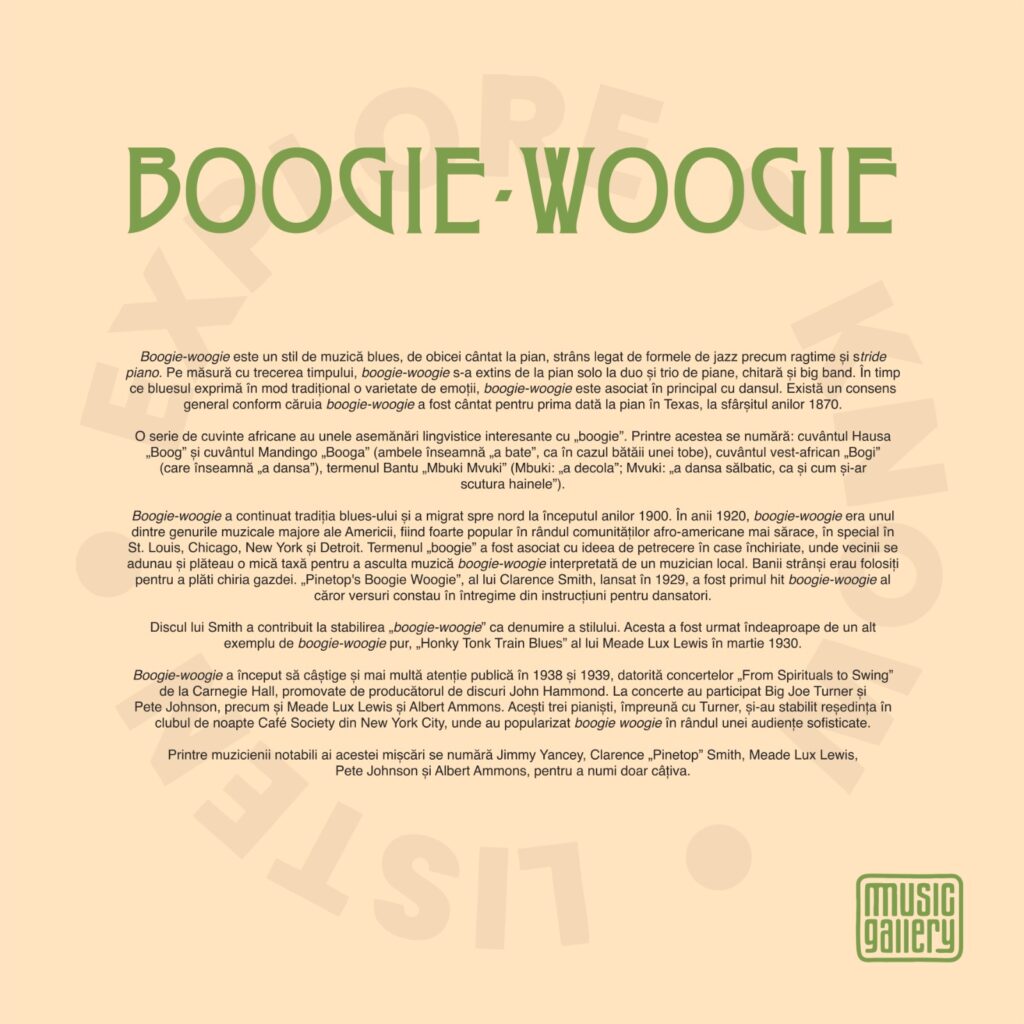
BOOGIE-WOOGIE
Boogie-woogie is a style of blues music, usually played on the piano, closely related to jazz forms such as ragtime and stride piano. Over time, boogie-woogie expanded from solo piano to piano duos and trios, guitar, and big band. While blues traditionally expresses a variety of emotions, boogie-woogie is primarily associated with dance. There is a general consensus that boogie-woogie was first played on the piano in Texas in the late 1870s.
A series of African words have some interesting linguistic similarities to “boogie.” These include the Hausa word “Boog” and the Mandingo word “Booga” (both meaning “to beat,” as in beating a drum), the West African word “Bogi” (meaning “to dance”), and the Bantu term “Mbuki Mvuki” (Mbuki: “to take off”; Mvuki: “to dance wildly, as if shaking off one’s clothes”).
Boogie-woogie continued the tradition of the blues and migrated north in the early 1900s. In the 1920s, boogie-woogie was one of America’s major musical genres, being very popular among poorer African American communities, especially in St. Louis, Chicago, New York, and Detroit. The term “boogie” was associated with the idea of parties in rented homes, where neighbors would gather and pay a small fee to listen to boogie-woogie music played by a local musician. The money collected was used to pay the host’s rent. Clarence Smith’s “Pinetop’s Boogie Woogie,” released in 1929, was the first boogie-woogie hit whose lyrics consisted entirely of instructions for dancers.
Smith’s record helped establish “boogie-woogie” as the name of the style. This was closely followed by another pure boogie-woogie example, Meade Lux Lewis’s “Honky Tonk Train Blues” in March 1930.
Boogie-woogie began to gain even more public attention in 1938 and 1939, thanks to the “From Spirituals to Swing” concerts at Carnegie Hall, promoted by record producer John Hammond. The concerts featured Big Joe Turner and Pete Johnson, as well as Meade Lux Lewis and Albert Ammons. These three pianists, along with Turner, took up residence at the Cafe Society nightclub in New York City, where they popularized boogie-woogie among a sophisticated audience.
Notable musicians of this movement include Jimmy Yancey, Clarence “Pinetop” Smith, Meade Lux Lewis, Pete Johnson, and Albert Ammons, to name just a few.
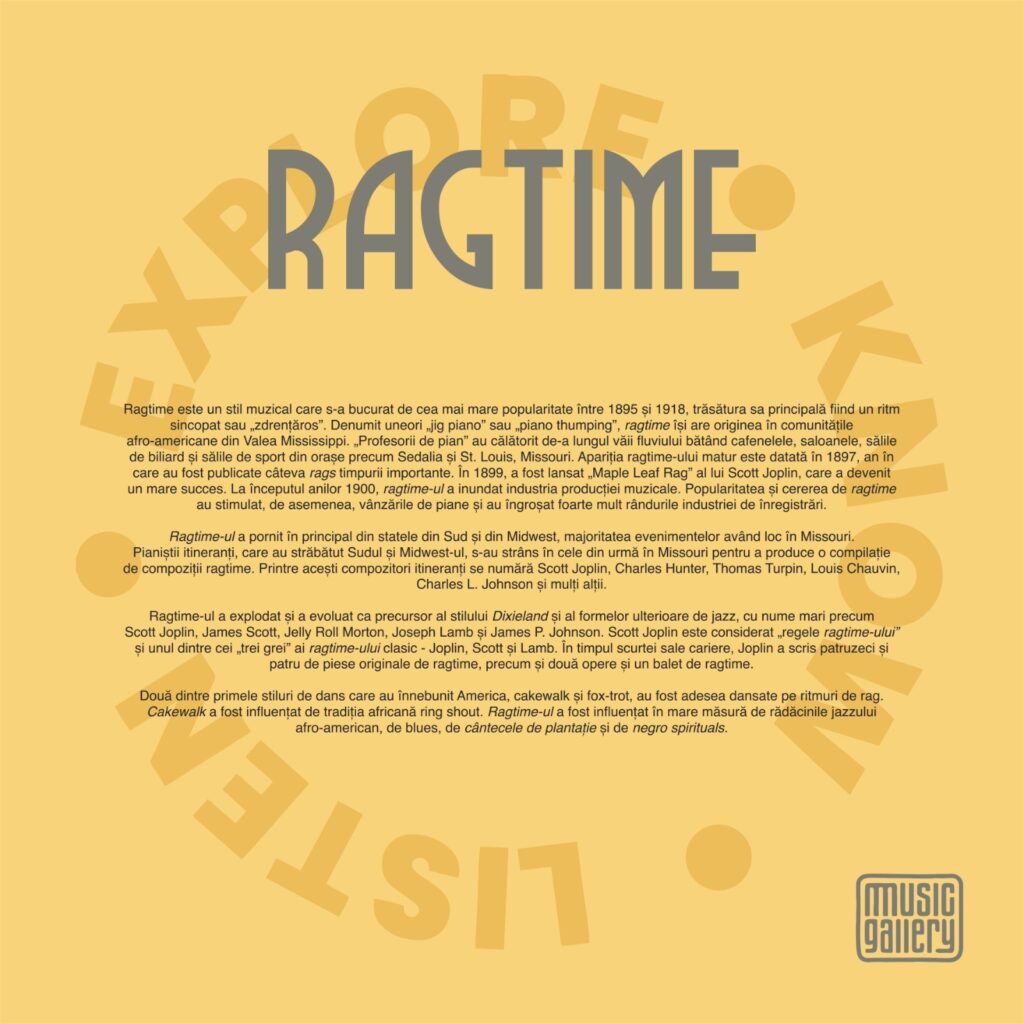
RAGTIME
Ragtime is a musical style that enjoyed its greatest popularity between 1895 and 1918, its main characteristic being a syncopated or “ragged” rhythm. Sometimes called “jig piano” or “piano thumping,” ragtime originated in African American communities in the Mississippi Valley. “Piano professors” traveled along the river valley, playing in cafes, saloons, billiard halls, and sports arenas in cities like Sedalia and St. Louis, Missouri. The mature form of ragtime is dated to 1897, when some important early rags were published. In 1899, Scott Joplin’s “Maple Leaf Rag” was released and became a huge success. In the early 1900s, ragtime flooded the music production industry. The popularity and demand for ragtime also stimulated piano sales and greatly thickened the ranks of the recording industry.
Ragtime primarily originated in the southern and midwestern states, with most events taking place in Missouri. Itinerant pianists who traveled throughout the South and Midwest eventually converged in Missouri to produce a compilation of ragtime compositions. Among these itinerant composers were Scott Joplin, Charles Hunter, Thomas Turpin, Louis Chauvin, Charles L. Johnson, and many others.
Ragtime exploded and evolved as a precursor to Dixieland style and later forms of jazz, with notable names like Scott Joplin, James Scott, Jelly Roll Morton, Joseph Lamb, and James P. Johnson. Scott Joplin is considered the “king of ragtime” and one of the “big three” of classic ragtime – Joplin, Scott, and Lamb. During his short career, Joplin wrote forty-four original ragtime pieces, as well as two operas and a ragtime ballet.
Two of the first dance styles that swept America, the cakewalk and the fox-trot, were often danced to ragtime rhythms. The cakewalk was influenced by the African tradition of ring shout. Ragtime was heavily influenced by the African American jazz roots, blues, plantation songs, and negro spirituals.
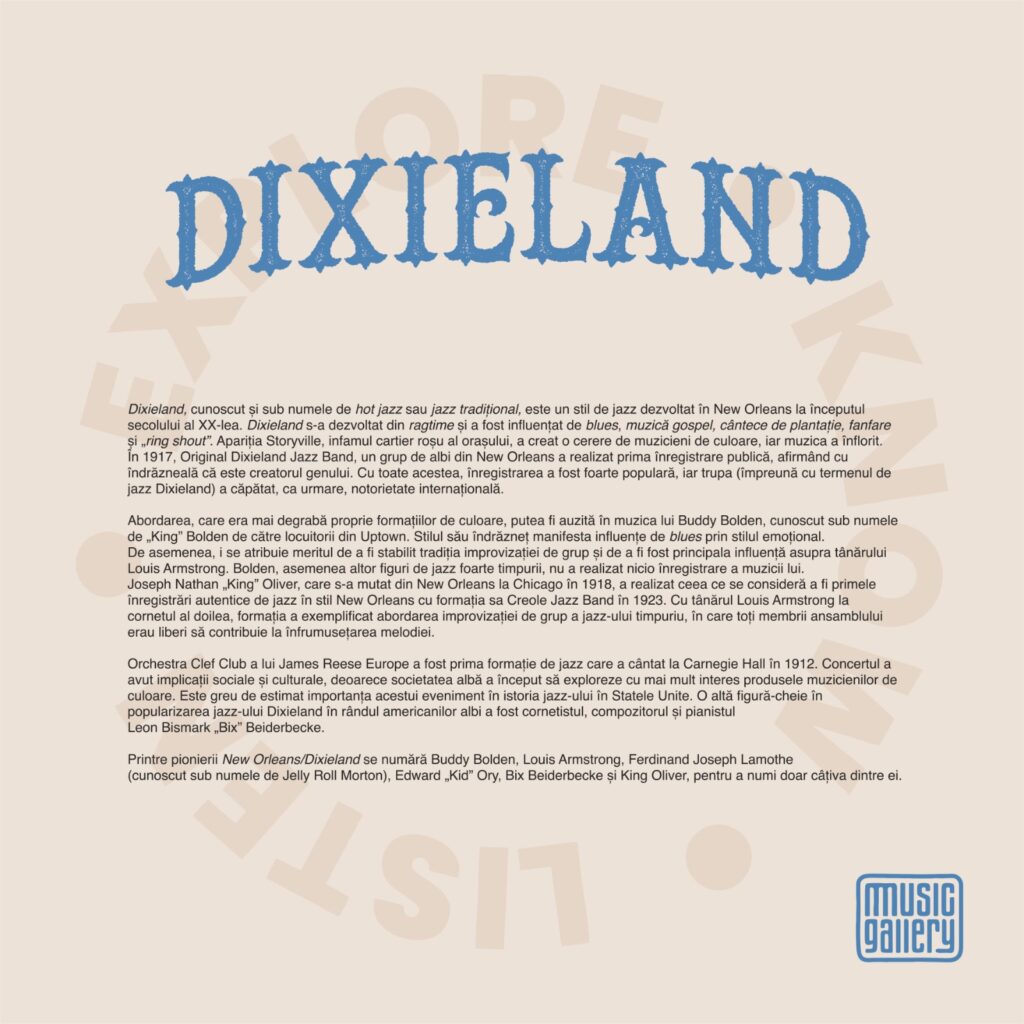
DIXIELAND
Dixieland, also known as hot jazz or traditional jazz, is a style of jazz that originated in New Orleans in the early 20th century. Dixieland evolved from ragtime and was influenced by blues, gospel music, plantation songs, brass bands, and ring shouts. The emergence of Storyville, the infamous red-light district of the city, created a demand for black musicians, and the music flourished. In 1917, the Original Dixieland Jazz Band, a group of white musicians from New Orleans, made the first public recording, boldly claiming to be the creators of the genre. However, the recording became very popular, and the band (along with the term Dixieland jazz) gained international notoriety as a result.
The approach, which was more characteristic of black ensembles, could be heard in the music of Buddy Bolden, known as “King” Bolden by the residents of Uptown. His bold style showed influences of blues through his emotional playing. He is also credited with establishing the tradition of group improvisation and being the main influence on young Louis Armstrong. Bolden, like other very early jazz figures, did not make any recordings of his music. Joseph Nathan “King” Oliver, who moved from New Orleans to Chicago in 1918, made what is considered to be the first authentic recordings of New Orleans-style jazz with his Creole Jazz Band in 1923. With young Louis Armstrong on second cornet, the band exemplified the group improvisation approach of early jazz, in which all members were free to contribute to the embellishment of the melody.
James Reese Europe’s Clef Club Orchestra was the first jazz ensemble to perform at Carnegie Hall in 1912. The concert had social and cultural implications, as white society began to explore with greater interest the products of black musicians. The importance of this event in the history of jazz in the United States is difficult to estimate. Another key figure in popularizing Dixieland jazz among white Americans was cornetist, composer, and pianist Leon Bismark “Bix” Beiderbecke.
Among the New Orleans/Dixieland pioneers are Buddy Bolden, Louis Armstrong, Ferdinand Joseph Lamothe (known as Jelly Roll Morton), Edward “Kid” Ory, Bix Beiderbecke, and King Oliver, to name just a few.
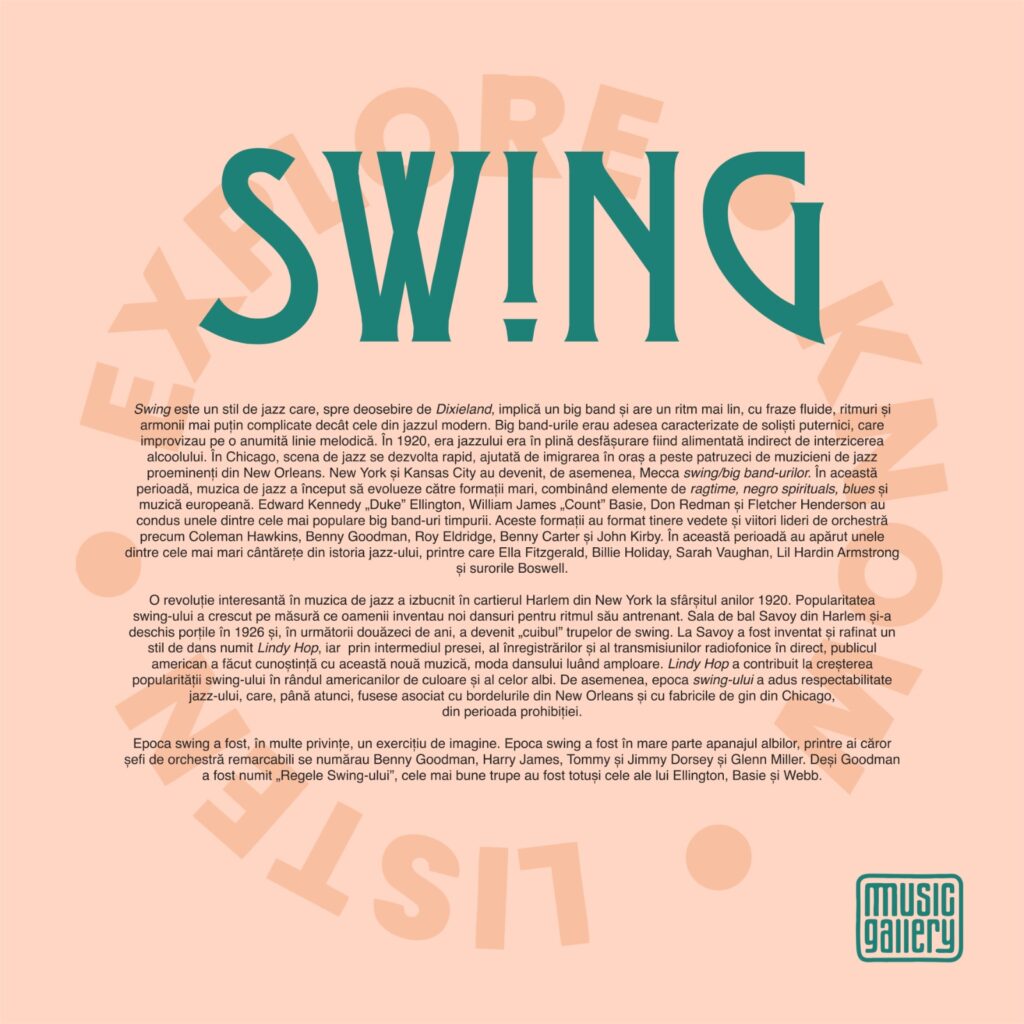
SWING
Swing is a style of jazz which, unlike Dixieland, involves a big band and has a smoother rhythm with fluid phrases, rhythms, and harmonies that are less complex than those in modern jazz. Big bands were often characterized by powerful soloists who improvised on a certain melodic line. In the 1920s, jazz was in full swing, indirectly fueled by the prohibition of alcohol. In Chicago, the jazz scene was rapidly developing, aided by the migration of over forty prominent jazz musicians from New Orleans to the city. New York and Kansas City also became meccas for swing/big bands. During this period, jazz music began to evolve towards larger ensembles, combining elements of ragtime, negro spirituals, blues, and European music. Edward Kennedy “Duke” Ellington, William James “Count” Basie, Don Redman, and Fletcher Henderson led some of the most popular early big bands. These bands nurtured young stars and future orchestra leaders such as Coleman Hawkins, Benny Goodman, Roy Eldridge, Benny Carter, and John Kirby. Some of the greatest female jazz singers in history emerged during this period, including Ella Fitzgerald, Billie Holiday, Sarah Vaughan, Lil Hardin Armstrong, and the Boswell Sisters.
An interesting revolution in jazz music broke out in the Harlem neighborhood of New York in the late 1920s. The popularity of swing grew as people invented new dances for its catchy rhythm. The Savoy Ballroom in Harlem opened its doors in 1926 and, over the next twenty years, became the “nest” of swing bands. At the Savoy, a style of dance called the Lindy Hop was invented and refined, and through the press, recordings, and live radio broadcasts, the American public became acquainted with this new music, with dance fashion taking off. The Lindy Hop contributed to the growing popularity of swing among black and white Americans. Additionally, the swing era brought respectability to jazz, which until then had been associated with New Orleans brothels and Chicago gin factories during the prohibition era.
The swing era was, in many ways, an exercise in image-making. The swing era was largely the province of white musicians, among whose notable bandleaders were Benny Goodman, Harry James, Tommy and Jimmy Dorsey, and Glenn Miller. Although Goodman was dubbed the “King of Swing,” the best bands were still those of Ellington, Basie, and Webb.
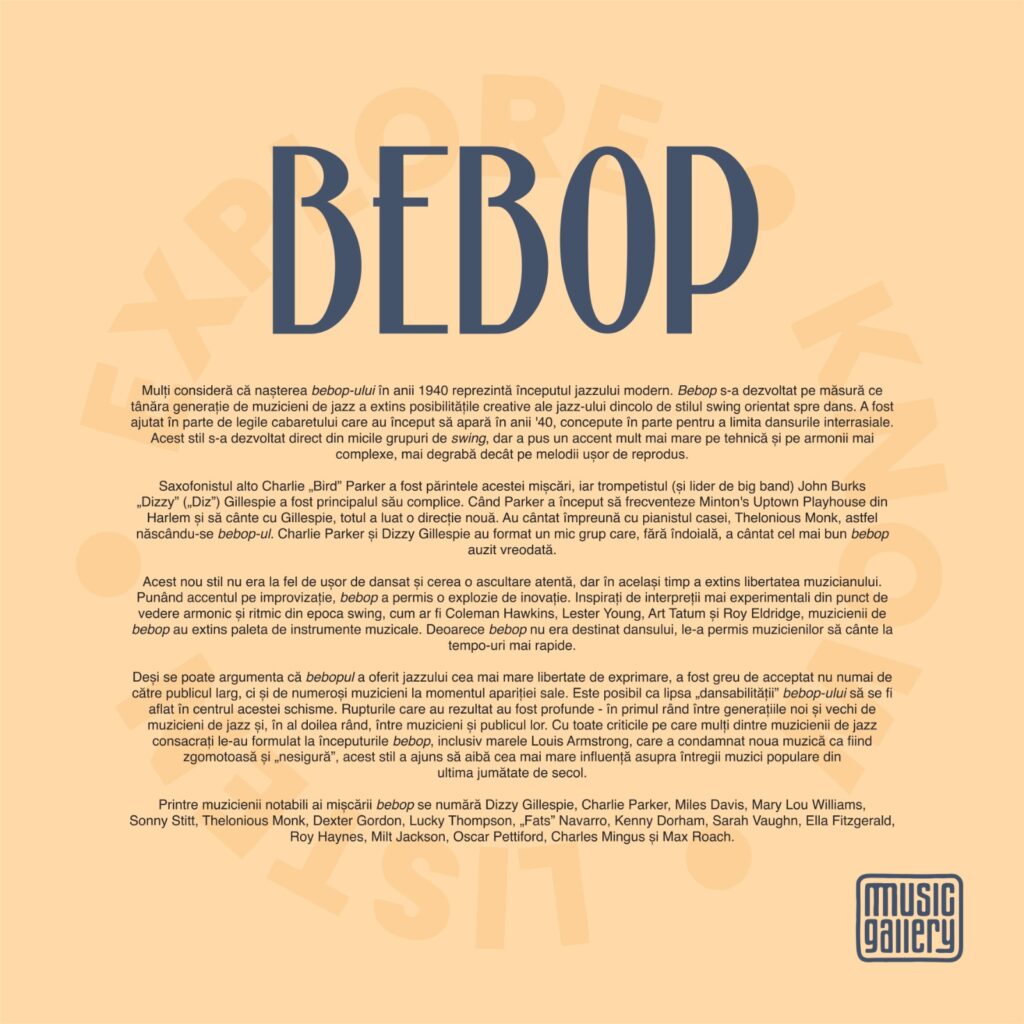
BEBOP
Many consider the birth of bebop in the 1940s to be the beginning of modern jazz. Bebop developed as the young generation of jazz musicians extended the creative possibilities of jazz beyond the dance-oriented swing style. It was partly helped by cabaret laws that began to emerge in the 1940s, designed in part to limit interracial dances. This style developed directly from small swing groups, but placed much greater emphasis on technique and more complex harmonies, rather than easily reproducible melodies.
Saxophonist alto Charlie “Bird” Parker was the father of this movement, and trumpeter (and big band leader) John Burks “Dizzy” (“Diz”) Gillespie was his main accomplice. When Parker began frequenting Minton’s Uptown Playhouse in Harlem and playing with Gillespie, everything took a new direction. They played together with the house pianist, Thelonious Monk, thus giving birth to bebop. Charlie Parker and Dizzy Gillespie formed a small group that undoubtedly played the best bebop ever heard.
This new style was not as easy to dance to and required careful listening, but at the same time, it extended the musician’s freedom. By emphasizing improvisation, bebop allowed for an explosion of innovation. Inspired by more harmonically and rhythmically experimental performers from the swing era, such as Coleman Hawkins, Lester Young, Art Tatum, and Roy Eldridge, bebop musicians expanded the palette of musical instruments. Because bebop was not intended for dancing, it allowed musicians to play at faster tempos.
Although it can be argued that bebop offered jazz the greatest freedom of expression, it was difficult to accept not only by the general public but also by numerous musicians at the time of its appearance. The lack of “danceability” of bebop may have been at the center of this schism. The ruptures that resulted were profound – first and foremost between the new and old generations of jazz musicians, and secondly between musicians and their audience. Despite the criticisms that many established jazz musicians formulated at the beginning of bebop, including the great Louis Armstrong, who condemned the new music as noisy and “uncertain,” this style has come to have the greatest influence on all popular music in the last half-century.
Notable musicians of the bebop movement include Dizzy Gillespie, Charlie Parker, Miles Davis, Mary Lou Williams, Sonny Stitt, Thelonious Monk, Dexter Gordon, Lucky Thompson, “Fats” Navarro, Kenny Dorham, Sarah Vaughan, Ella Fitzgerald, Roy Haynes, Milt Jackson, Oscar Pettiford, Charles Mingus, and Max Roach.
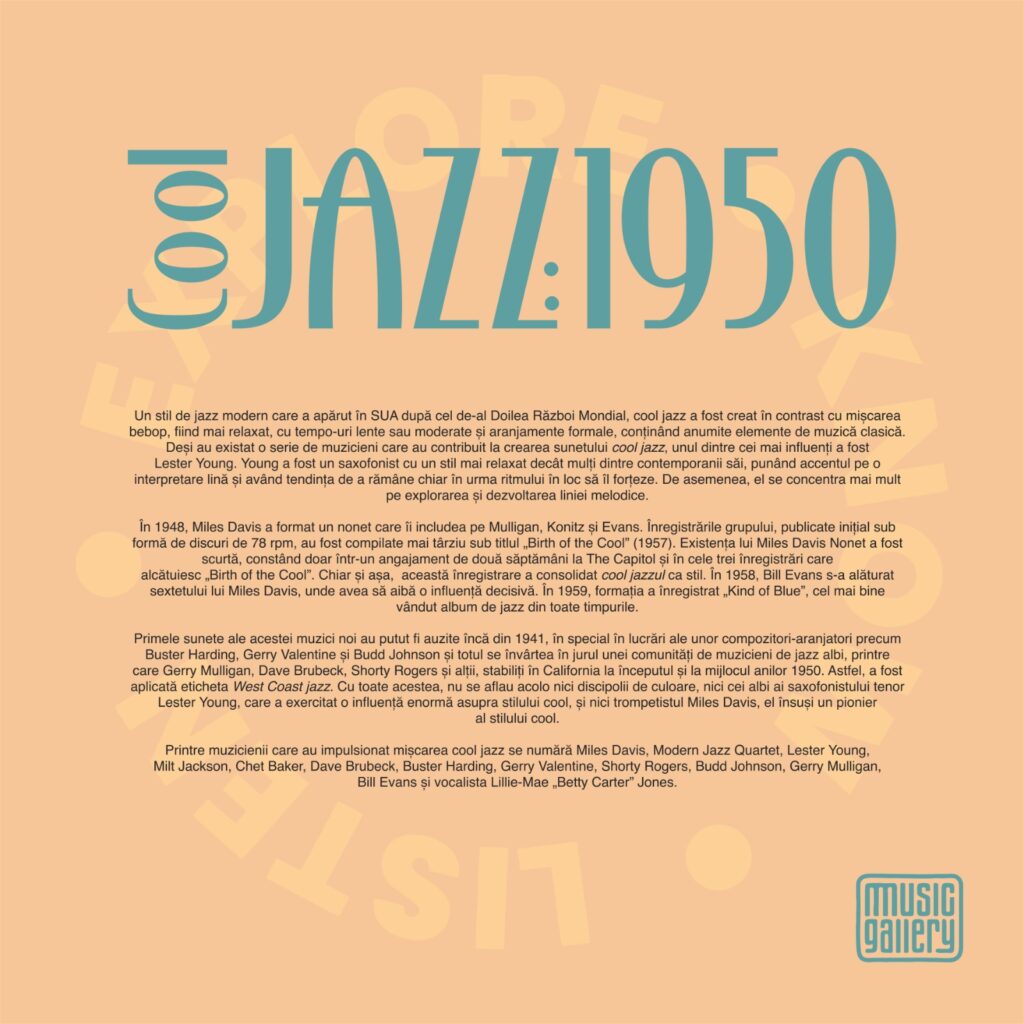
COOL JAZZ: 1950
A modern jazz style that emerged in the US after World War II, cool jazz was created in contrast to the bebop movement, being more relaxed, with slow or moderate tempos and formal arrangements, containing certain elements of classical music. Although there were a number of musicians who contributed to the creation of the cool jazz sound, one of the most influential was Lester Young. Young was a saxophonist with a more relaxed style than many of his contemporaries, emphasizing a smooth performance and tending to lag behind the rhythm instead of forcing it. He also focused more on exploring and developing the melodic line.
In 1948, Miles Davis formed a nonet that included Mulligan, Konitz, and Evans. The group’s recordings, initially released as 78 rpm discs, were later compiled under the title “Birth of the Cool” (1957). The existence of Miles Davis Nonet was short-lived, consisting of only a two-week engagement at The Capitol and the three recordings that make up “Birth of the Cool.” Even so, this recording solidified cool jazz as a style. In 1958, Bill Evans joined Miles Davis’s sextet, where he would have a decisive influence. In 1959, the group recorded “Kind of Blue,” the best-selling jazz album of all time.
The first sounds of this new music could be heard as early as 1941, especially in the works of composers-arrangers such as Buster Harding, Gerry Valentine, and Budd Johnson, and everything revolved around a community of white jazz musicians, including Gerry Mulligan, Dave Brubeck, Shorty Rogers, and others, established in California in the early and mid-1950s. Thus, the label West Coast jazz was applied. However, neither the black disciples nor the white ones of tenor saxophonist Lester Young, who had a tremendous influence on the cool style, nor the trumpeter Miles Davis himself, a pioneer of the cool style, were there.
Among the musicians who drove the cool jazz movement were Miles Davis, Modern Jazz Quartet, Lester Young, Milt Jackson, Chet Baker, Dave Brubeck, Buster Harding, Gerry Valentine, Shorty Rogers, Budd Johnson, Gerry Mulligan, Bill Evans, and vocalist Lillie-Mae “Betty Carter” Jones.
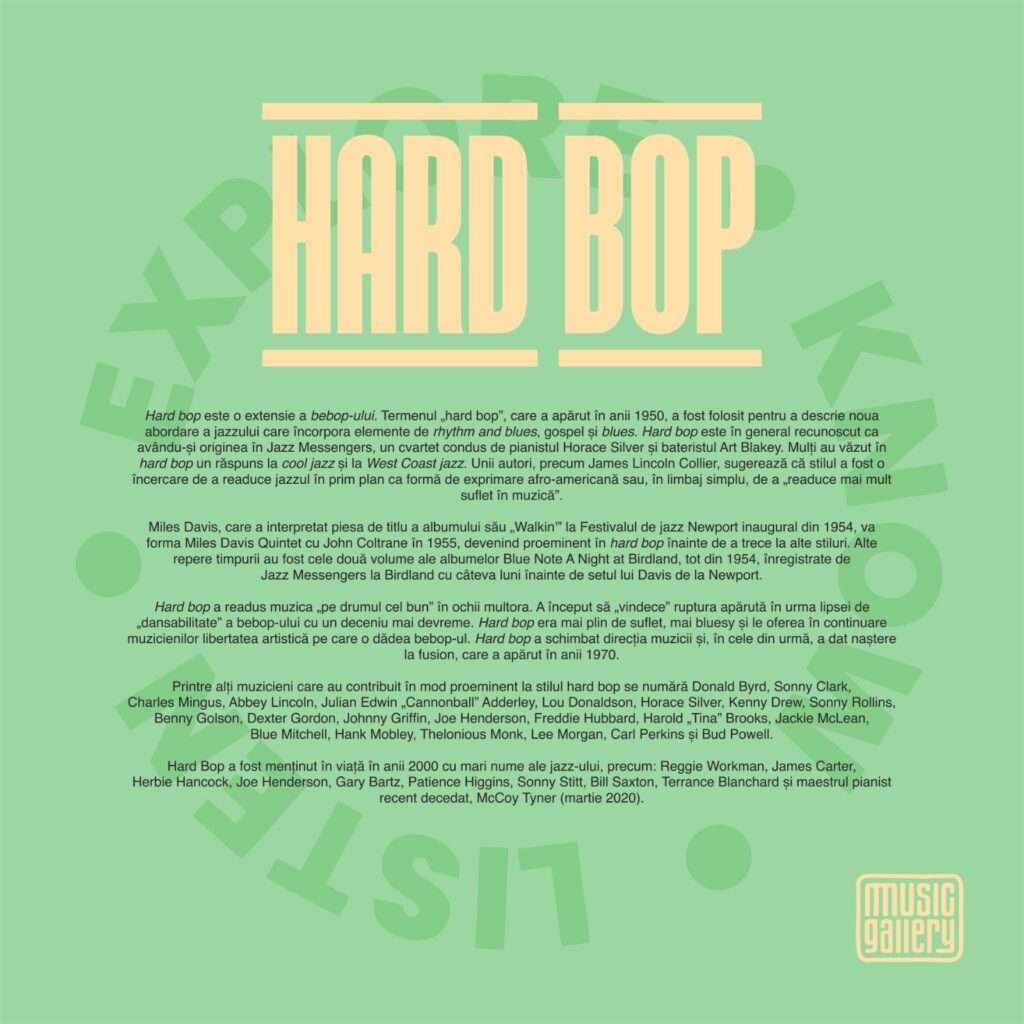
HARD BOP
Hard bop is an extension of bebop. The term “hard bop”, which emerged in the 1950s, was used to describe the new approach to jazz that incorporated elements of rhythm and blues, gospel, and blues. Hard bop is generally recognized as having its origins in the Jazz Messengers, a quartet led by pianist Horace Silver and drummer Art Blakey. Many saw hard bop as a response to cool jazz and West Coast jazz. Some authors, such as James Lincoln Collier, suggest that the style was an attempt to bring jazz back to the forefront as an African American form of expression or, in simpler terms, to “put more soul into the music”.
Miles Davis, who performed the title track of his album “Walkin'” at the inaugural Newport Jazz Festival in 1954, formed the Miles Davis Quintet with John Coltrane in 1955, becoming prominent in hard bop before moving on to other styles. Other early landmarks were the two volumes of the Blue Note album A Night at Birdland, also from 1954, recorded by the Jazz Messengers at Birdland a few months before Davis’ set at Newport.
Hard bop brought the music “back on track” in the eyes of many. It began to “heal” the rift caused by the lack of “danceability” of bebop a decade earlier. Hard bop was more soulful, more bluesy, and still offered the artistic freedom that bebop gave musicians. Hard bop changed the direction of music and eventually gave rise to fusion, which emerged in the 1970s.
Among other musicians who prominently contributed to the hard bop style are Donald Byrd, Sonny Clark, Charles Mingus, Abbey Lincoln, Julian Edwin “Cannonball” Adderley, Lou Donaldson, Horace Silver, Kenny Drew, Sonny Rollins, Benny Golson, Dexter Gordon, Johnny Griffin, Joe Henderson, Freddie Hubbard, Harold “Tina” Brooks, Jackie McLean, Blue Mitchell, Hank Mobley, Thelonious Monk, Lee Morgan, Carl Perkins, and Bud Powell.
Hard bop has been kept alive in the 2000s by great names in jazz, such as Reggie Workman, James Carter, Herbie Hancock, Joe Henderson, Gary Bartz, Patience Higgins, Sonny Stitt, Bill Saxton, Terrance Blanchard, and the recently deceased master pianist, McCoy Tyner (March 2020).
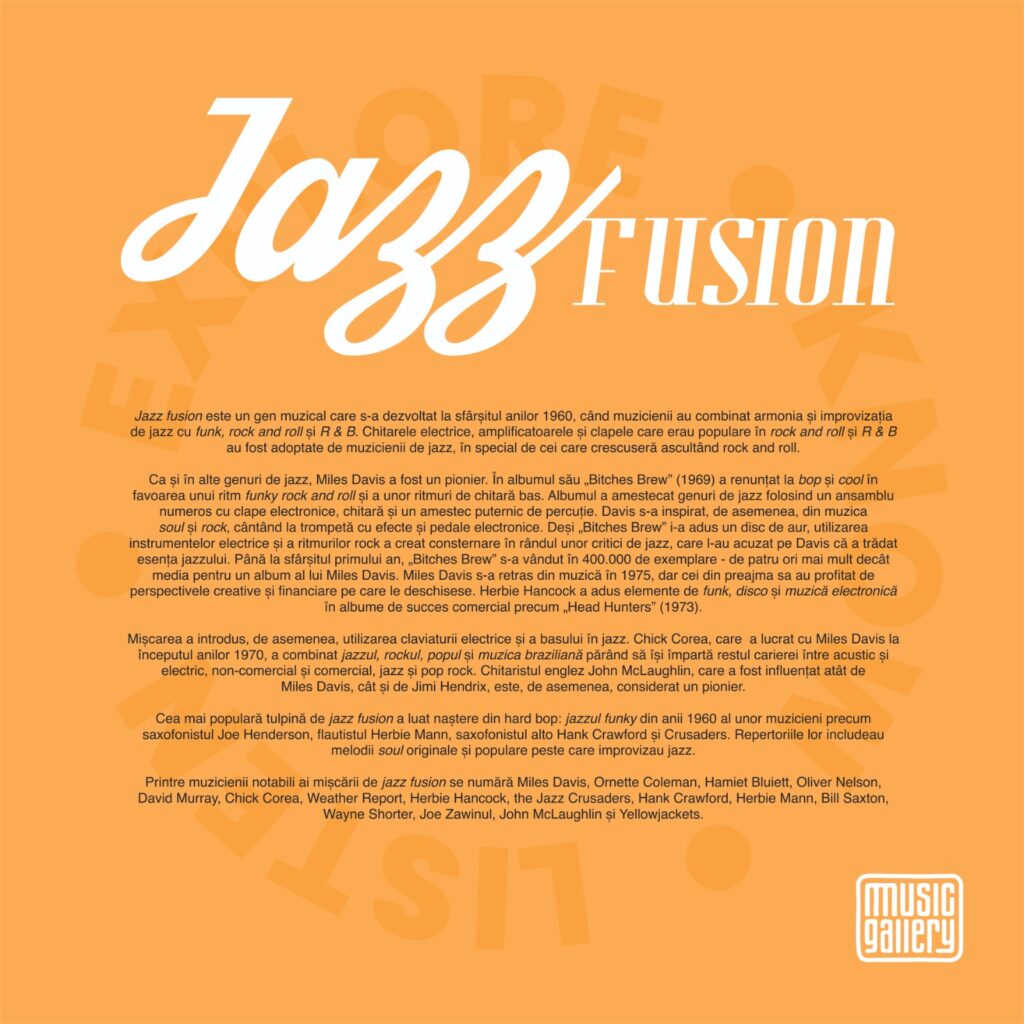
JAZZ FUSION
Jazz fusion is a musical genre that developed in the late 1960s, when musicians combined the harmony and improvisation of jazz with funk, rock and roll, and R&B. Electric guitars, amplifiers, and keyboards popular in rock and R&B were adopted by jazz musicians, especially those who grew up listening to rock and roll.
As in other jazz genres, Miles Davis was a pioneer. In his album “Bitches Brew” (1969), he abandoned bop and cool in favor of a funky rock and roll rhythm and bass guitar rhythms. The album mixed jazz genres using a large ensemble with electronic keyboards, guitar, and a strong percussion mix. Davis also drew inspiration from soul and rock music, playing trumpet with electronic effects and pedals. Although “Bitches Brew” earned him a gold record, the use of electric instruments and rock rhythms created consternation among some jazz critics, who accused Davis of betraying the essence of jazz. By the end of the first year, “Bitches Brew” sold 400,000 copies – four times more than the average for a Miles Davis album. Miles Davis retired from music in 1975, but those around him profited from the creative and financial prospects he had opened up. Herbie Hancock brought elements of funk, disco, and electronic music into commercially successful albums like “Head Hunters” (1973).
The movement also introduced the use of electric keyboards and bass in jazz. Chick Corea, who worked with Miles Davis in the early 1970s, combined jazz, rock, pop, and Brazilian music, seeming to divide the rest of his career between acoustic and electric, non-commercial and commercial, jazz and pop rock. English guitarist John McLaughlin, who was influenced by both Miles Davis and Jimi Hendrix, is also considered a pioneer.
The most popular strain of jazz fusion originated from hard bop: the funky jazz of 1960s musicians such as saxophonist Joe Henderson, flutist Herbie Mann, alto saxophonist Hank Crawford, and Crusaders. Their repertoires included original and popular soul melodies over which they improvised jazz.
Notable musicians of the jazz fusion movement include Miles Davis, Ornette Coleman, Hamiet Bluiett, Oliver Nelson, David Murray, Chick Corea, Weather Report, Herbie Hancock, the Jazz Crusaders, Hank Crawford, Herbie Mann, Bill Saxton, Wayne Shorter, Joe Zawinul, John McLaughlin, and Yellowjackets.

HIP-HOP / RAP
It is said that the hip-hop genre originated in the poorest and most neglected ghetto in New York City, created by young people of color and Latino Americans as part of a culture that also produced rap, breakdancing, and graffiti art. Rejected by American society, these young people used rap to speak the brutal truth about their lives. However, hip-hop music was not officially recorded for radio or television until 1979, largely due to a lack of acceptance outside the ghettos. Hip-hop is deeply rooted in African call-and-response and ring shout traditions.
It is important to note that the commercial success of hip-hop led to the emergence of radio stations that exclusively played hip-hop and targeted young people of all ethnic groups. This development created the second major schism in jazz, disconnecting young people of color from the music of previous generations. The first schism was created by the lack of “danceability” of bebop.
The Sugarhill Gang’s 1979 song “Rapper’s Delight” is considered the first hip-hop recording to gain widespread popularity. Notable artists from this period include DJ Kool Herc, Grandmaster Flash and the Furious Five, Fab Five Freddy, Marley Marl, Afrika Bambaataa, Kool Moe Dee, Kurtis Blow, Doug E. Fresh, Whodini, Warp 9, The Fat Boys, and Spoonie Gee.
The “golden age” of the genre is considered the period of mainstream hip-hop production between the mid-1980s and early 1990s, characterized by diversity, quality, innovation, and influence. The lyrics of hip-hop during the golden age had strong themes of Afrocentrism and political militancy. The artists and groups most commonly associated with this phase are Public Enemy, Boogie Down Productions, Eric B. & Rakim, De La Soul, A Tribe Called Quest, Gang Starr, Big Daddy Kane, P-Diddy, Will Smith, Nas, and Jungle Brothers.
Gangsta rap, a subgenre that often focuses on the violence and poverty faced by young people of color in the inner city, emerged during this wave. Schoolly D, N.W.A., Ice-T, Ice Cube, and Geto Boys are founding artists of the subgenre. On the West Coast, the G-funk style dominated in the 1990s, with artists such as Tupac, Dr. Dre, and Snoop Dogg, while East Coast hip-hop was dominated by the hardcore rap of artists like Mobb Deep, Wu-Tang Clan, Onyx, as well as the jazz rap and Afrocentric hip-hop of the Native Tongues group.
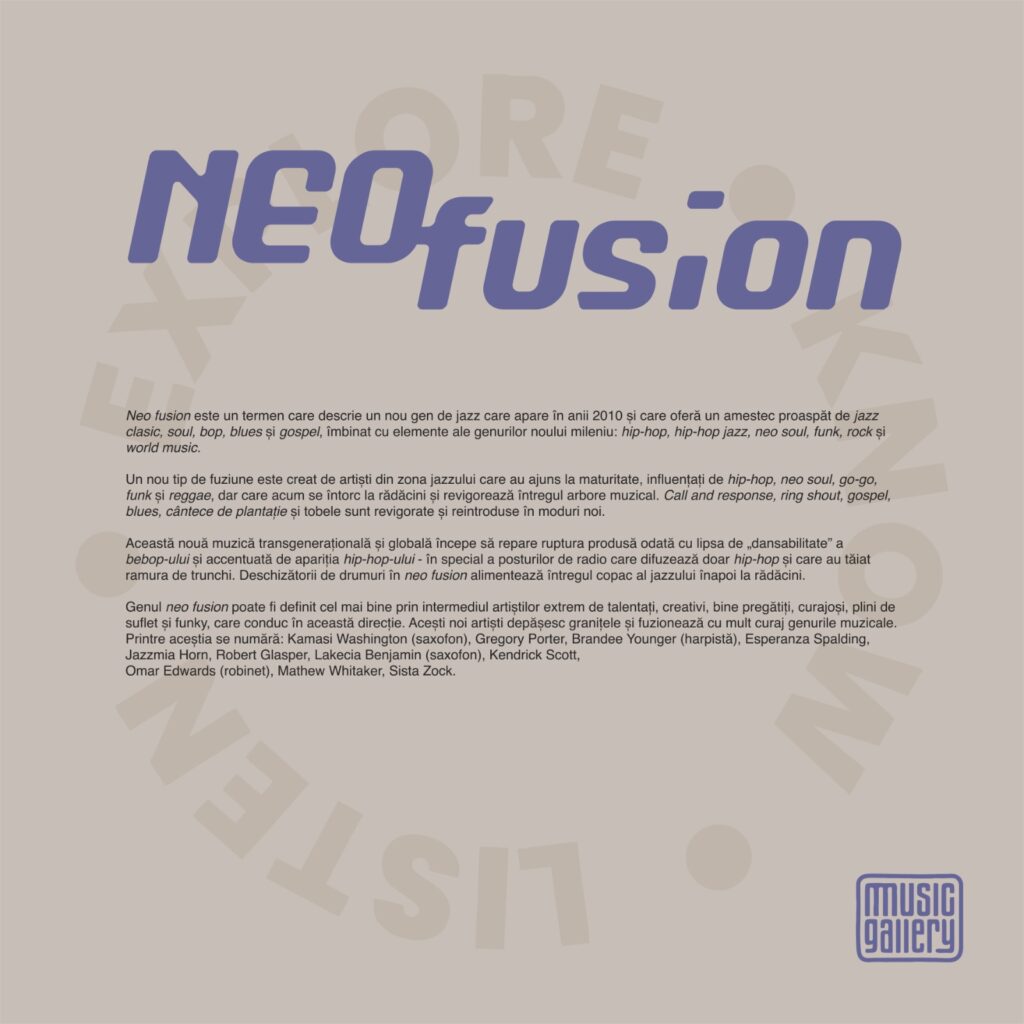
NEO FUSION
Neo fusion is a term that describes a new genre of jazz that emerged in the 2010s, offering a fresh blend of classic jazz, soul, bop, blues, and gospel, combined with elements of new millennium genres such as hip-hop, hip-hop jazz, neo soul, funk, rock, and world music.
A new type of fusion is being created by jazz artists who have matured and been influenced by hip-hop, neo soul, go-go, funk, and reggae, but are now returning to their roots and revitalizing the entire musical tree. Call and response, ring shout, gospel, blues, plantation songs, and drums are being revitalized and reintroduced in new ways.
This new transgenerational and global music is beginning to repair the rupture caused by the lack of “danceability” in bebop and exacerbated by the emergence of hip-hop – especially radio stations that play only hip-hop and have cut off the trunk branch. Neo fusion pioneers are fueling the entire jazz tree back to its roots.
The neo fusion genre can be best defined through extremely talented, creative, well-prepared, soulful, and funky artists who lead in this direction. These new artists are breaking boundaries and fearlessly fusing musical genres. Among them are Kamasi Washington (saxophone), Gregory Porter, Brandee Younger (harpist), Esperanza Spalding, Jazzmia Horn, Robert Glasper, Lakecia Benjamin (saxophone), Kendrick Scott, Omar Edwards (tap), Mathew Whitaker, and Sista Zock.
